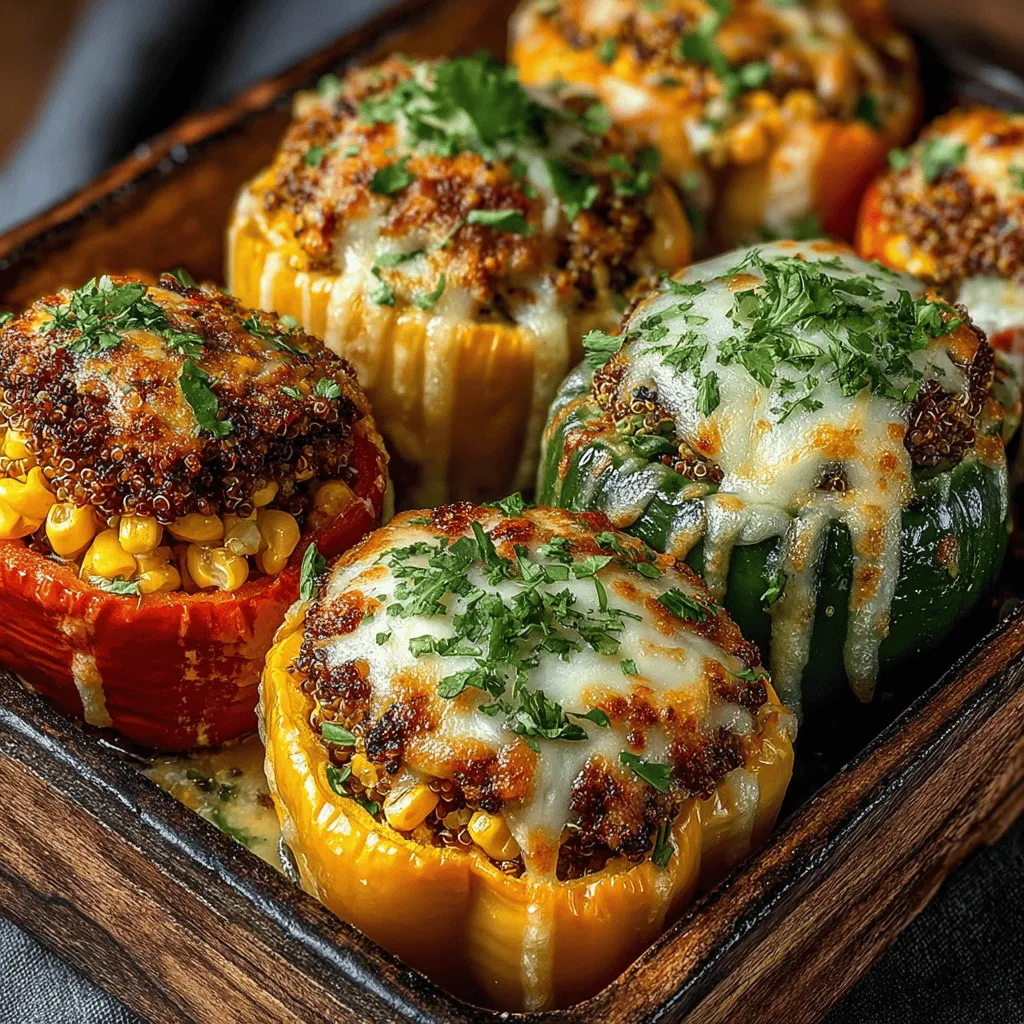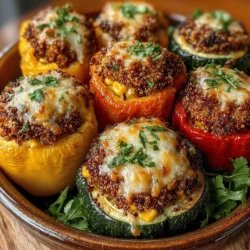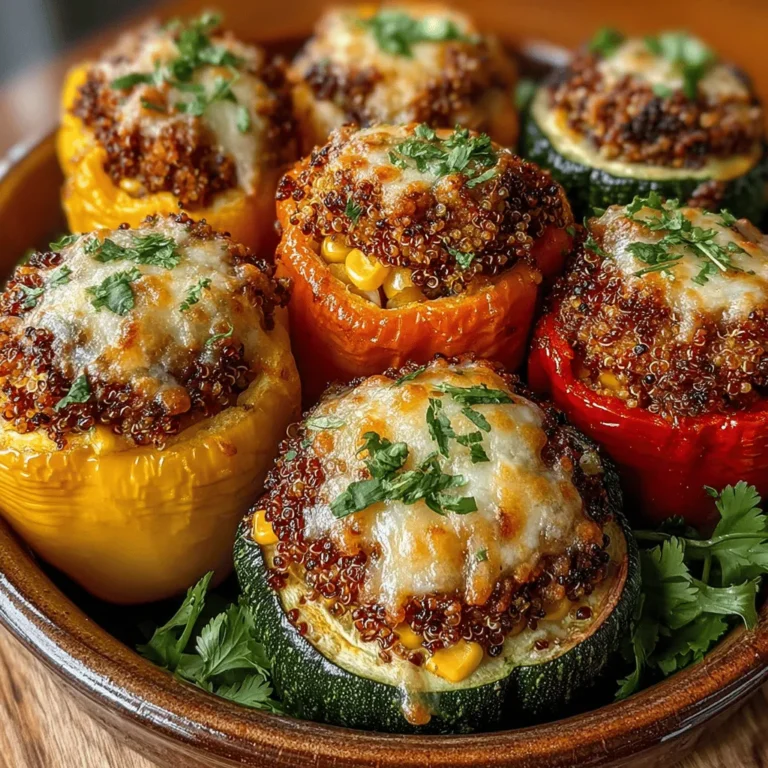Stuffed peppers are a delightful way to incorporate a variety of nutrients into one colorful dish. These versatile vessels can be filled with an array of ingredients, but the combination of lentils and quinoa makes for an exceptionally healthy option. Colorful bell peppers not only serve as an eye-catching base but also bring a range of flavors and nutrients that enhance the overall appeal of this dish. Lentils and quinoa are packed with protein and fiber, making them excellent choices for a balanced diet.
Ingredients
– 4 large bell peppers (any color: red, yellow, green, or orange)
– 1 cup cooked lentils (green or brown)
– 1 cup cooked quinoa
– 1 small onion, diced
– 2 cloves garlic, minced
– 1 medium zucchini, diced
– 1 medium carrot, diced
– 1 cup corn (fresh, frozen, or canned)
– 1 teaspoon cumin
– 1 teaspoon smoked paprika
– Salt and pepper to taste
– 1 tablespoon olive oil
– Fresh parsley or cilantro for garnish (optional)
Instructions
1. Preheat your oven to 375°F (190°C).
2. Prepare the bell peppers by cutting the tops off and removing the seeds and membranes. Rinse under cold water and set aside.
3. In a medium saucepan, heat the olive oil over medium heat. Add the diced onion and garlic, sautéing until fragrant and translucent (about 3-4 minutes).
4. Add the diced zucchini and carrot to the pan, continuing to sauté until softened (about 5 minutes).
5. Stir in the cooked lentils, cooked quinoa, corn, cumin, smoked paprika, salt, and pepper. Mix well to combine and heat through (about 3 minutes).
6. Carefully stuff each bell pepper with the lentil and vegetable mixture, packing it in gently to ensure they are filled.
7. Place the stuffed peppers upright in a baking dish. If desired, pour a small amount of water into the bottom of the dish to create steam during baking.
8. Cover the baking dish with aluminum foil and bake for 25 minutes. Remove the foil and bake for an additional 10-15 minutes, until the peppers are tender and slightly charred.
9. Remove from the oven and let cool slightly before serving. Garnish with fresh parsley or cilantro if desired.
Understanding the Ingredients
The primary ingredients in this recipe are bell peppers, lentils, and quinoa. Bell peppers are not only vibrant and visually appealing but also a rich source of vitamins A and C, antioxidants, and dietary fiber. Lentils are an excellent plant-based protein source, packed with iron and folate. Quinoa, often referred to as a superfood, is gluten-free and contains all nine essential amino acids, making it a complete protein. Using fresh vegetables enhances both flavor and nutritional value, ensuring that each bite is as healthy as it is delicious.
Preparing the Base: The Bell Peppers
When selecting bell peppers, look for ones that are firm, shiny, and free of blemishes. Each color of bell pepper offers a unique flavor profile; for instance, red peppers tend to be sweeter, while green peppers have a slightly bitter taste. To prepare the peppers for stuffing, slice the tops off using a sharp knife and carefully remove the seeds and membranes. Rinse the peppers under cold water to clean them thoroughly. This preparation ensures that they are ready to be filled and cooked without any unwanted bitterness.
Cooking the Quinoa
Quinoa is a nutritious grain that has gained popularity as a health food. Native to South America, it is rich in protein, fiber, and essential minerals. To cook quinoa perfectly, start by rinsing it thoroughly under cold water to remove its natural coating, called saponin, which can impart a bitter taste. Use a ratio of 2:1 water to quinoa for cooking. Bring the water to a boil, add the rinsed quinoa, then reduce the heat and let it simmer covered for about 15 minutes. You’ll know the quinoa is ready when it has absorbed all the water and the grains have expanded, revealing the germ ring.
Sautéing the Vegetables
Sautéing the vegetables is a crucial step for developing deep flavors in your stuffed peppers. Begin by choosing a mix of vegetables that complement the lentils and quinoa, such as zucchini and carrots. These vegetables not only add texture but also boost the nutritional profile of the dish. Heat oil in a skillet and add the diced onion and garlic first, allowing them to become fragrant before introducing the other vegetables. This technique not only enhances the flavor but also retains the nutrients in the vegetables, creating a filling that is both tasty and healthy.

Tips on Achieving the Perfect Texture and Taste in Sautéed Veggies
To elevate the flavor and texture of your sautéed vegetables, consider the following tips:
Use Fresh Ingredients
Fresh vegetables not only taste better but also retain more nutrients. Choose vibrant, seasonal produce for the best results.
Cut Uniformly
Ensure that your vegetables are cut into uniform pieces. This promotes even cooking and helps achieve that perfect tender-crisp texture.
Sauté in Batches
If you have a lot of vegetables, sauté them in batches. Overcrowding the pan can lead to steaming instead of sautéing, resulting in a less desirable texture.
Don’t Rush the Cooking Process
Allow each vegetable to cook sufficiently before adding the next. Start with denser vegetables like bell peppers and carrots, and finish with quicker-cooking items like spinach or zucchini.
Creating the Flavorful Filling
Combining Lentils, Quinoa, and Veggies
The filling mixture for your stuffed peppers is key to creating a hearty and nutritious dish. Start by cooking lentils and quinoa separately until tender, then combine them with your sautéed vegetables. This mixture provides a delightful balance of protein, fiber, and texture.
The Role of Spices
Spices like cumin and smoked paprika are essential for enhancing the filling’s flavor. Cumin adds warmth and earthiness, while smoked paprika imparts a subtle smokiness that elevates the overall taste profile. Adjust the amounts to suit your preferences but remember that a little goes a long way.
Seasoning and Balancing Flavors
Don’t forget to season your filling generously. Taste as you go and balance flavors with salt, pepper, and perhaps a squeeze of lemon juice to brighten the dish. This step is crucial for ensuring that your stuffed peppers are bursting with flavor.
Stuffing the Peppers
Techniques for Filling Peppers
To fill the peppers efficiently, use a spoon or a small scoop. Start by spooning the filling into the base, then gently press down to pack it tightly. Continue adding until the peppers are filled to the brim.
Cheese Options
When it comes to cheese, consider your dietary preferences. Traditional options like mozzarella or cheddar provide creaminess, while dairy-free alternatives can offer similar textures without the lactose. Both choices can enhance the flavor profile of your stuffed peppers.
Visual Appeal
For an attractive presentation, arrange the filled peppers upright in a baking dish. Optionally, sprinkle some additional cheese on top for an appealing, bubbly finish.
Baking to Perfection
Baking Techniques
To bake your stuffed peppers perfectly, preheat your oven to 375°F (190°C). Place the peppers in a baking dish with a splash of vegetable broth at the bottom to keep them moist. Bake for 25-30 minutes until the peppers are tender.
The Role of Foil
Covering the dish with foil during the first half of baking helps steam the peppers, ensuring they cook through. Remove the foil in the last 10 minutes to allow the cheese to brown and bubble.
Achieving a Golden Cheese Topping
For that perfect golden cheese topping, keep an eye on the peppers during the last few minutes of baking. If you desire extra browning, you can turn on the broiler for a minute—just be cautious to prevent burning.
Serving Suggestions
Garnishing with Fresh Herbs
To elevate the dish further, garnish your stuffed peppers with freshly chopped herbs such as cilantro or parsley. This adds a pop of color and freshness that complements the flavors beautifully.
Recommended Side Dishes
Pair your stuffed peppers with a simple green salad or a light grain salad to balance the meal. A side of roasted vegetables or a tangy yogurt dip can also enhance the dining experience.
Creative Leftover Ideas
If you have leftover stuffed peppers, consider chopping them up and mixing them into a grain bowl, or use them as a filling for tacos. The flavors can be enjoyed in various forms, making them a versatile dish.
Conclusion
Colorful Lentil & Veggie Paradise Peppers are not only a feast for the eyes but also a powerhouse of nutrition. With their vibrant colors and wholesome ingredients, they provide a satisfying meal that can easily be customized to your liking. We encourage you to experiment with different vegetables, spices, and fillings to make this recipe your own. Embrace the joy of cooking by creating meals that are both nourishing and visually appealing, and share them with family and friends for a truly delightful experience.

